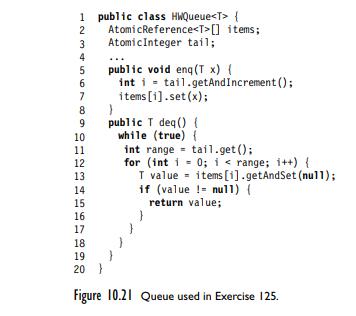Answered step by step
Verified Expert Solution
Question
1 Approved Answer
Consider the unbounded queue implementation shown in Fig. 10.21. This queue is blocking, meaning that the deq () method does not return until it has
Consider the unbounded queue implementation shown in Fig. 10.21. This queue is blocking, meaning that the deq () method does not return until it has found an item to dequeu

The queue has two fields: items is a very large array, and tail is the index of the next unused element in the array.
1. Are the enq () and deq () methods wait-free? If not, are they lock-free? Explain.
2. Identify the linearization points for enq () and deq(). (Careful! They may be execution-dependent.)
1 public class HWQueue ( 2 AtomicReference [] items; Atomic Integer tail; 3 4 5 6 7 public void enq (T x) { int i = tail.getAnd Increment (); items [1].set(x); } public T deq () ( while (true) { int range tail.get(); for (int i = 0; i < range; i++) { T value items [1].getAndSet (null); if (value != null) { return value; 8 9 10 11 12 13 14 15 16 17 18. 19 20 } Figure 10.21 Queue used in Exercise 125.
Step by Step Solution
There are 3 Steps involved in it
Step: 1
Lets analyze the provided queue implementation Waitfree or lockfree The enq method increments the ta...
Get Instant Access to Expert-Tailored Solutions
See step-by-step solutions with expert insights and AI powered tools for academic success
Step: 2

Step: 3

Ace Your Homework with AI
Get the answers you need in no time with our AI-driven, step-by-step assistance
Get Started


